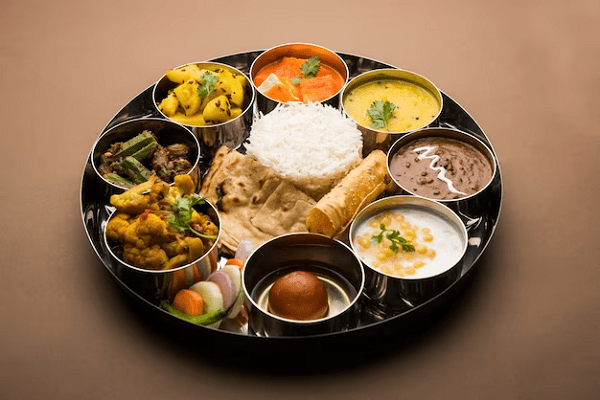Lunch- There are many types of lunches you can enjoy, depending on your preferences and dietary restrictions. Here are some common types of lunches:
- Sandwiches and Wraps: Sandwiches and wraps are a quick and convenient option. You can fill them with various ingredients like deli meats, cheese, vegetables, and condiments.
- Salads: Salads are a healthy choice and can be customized with a variety of greens, vegetables, proteins (such as grilled chicken or tofu), and dressings.
- Soups: Soups are comforting and come in various flavors and ingredients, from classic chicken noodle to vegetable, chili, and more.
- Leftovers: If you have leftovers from a previous meal, reheating and enjoying them for lunch is an efficient way to reduce food waste.
- Rice or Grain Bowls: These are versatile and can be made with rice, quinoa, or other grains, along with a mix of vegetables, proteins, and sauces or dressings.
- Pasta Dishes: Pasta salads or warm pasta dishes can be a satisfying lunch, with options like spaghetti, macaroni and cheese, or cold pasta salads.
- Sushi: If you enjoy Japanese cuisine, sushi rolls or bento boxes can be a delicious and light lunch choice.
- Fast Food: Popular fast-food options include burgers, chicken nuggets, fries, and more, often available at various fast-food chains.
- Pizza: Pizza comes in many styles, from thin-crust to deep-dish, and can be topped with a wide range of ingredients.
- Vegetarian or Vegan Options: If you follow a vegetarian or vegan diet, there are plenty of plant-based lunch options, including veggie wraps, grain bowls, and plant-based protein dishes.
- Tacos and Burritos: Mexican cuisine offers tasty choices like tacos and burritos, which can be filled with various meats, beans, and toppings.
- Asian Noodles: Noodle dishes like ramen, pad Thai, or lo mein are flavorful and popular choices for lunch.
- Mediterranean/Middle Eastern: Enjoy dishes like falafel, shawarma, or hummus in wraps or on platters.
- Quiches and Frittatas: These egg-based dishes can be filled with vegetables, cheese, and other ingredients for a satisfying lunch.
- Stir-Fries: Quick and healthy, stir-fries incorporate a mix of vegetables, proteins, and sauces served over rice or noodles.
- Grilled or Baked Protein: Grilled chicken, fish, or tofu with sides of vegetables and grains can make for a balanced lunch.
- Deli Platters: Create your own deli-style platter with cold cuts, cheeses, pickles, and bread.
- Gourmet Sandwiches: Elevate your sandwich game with premium ingredients like artisan bread, gourmet cheeses, and specialty spreads.
- Food Trucks: Many cities have food trucks that offer a diverse range of cuisines, making for a fun and unique lunch experience.
- DIY (Do It Yourself): Sometimes, a customized DIY lunch with ingredients you have on hand can be a creative and satisfying option.
Remember to consider your dietary preferences and any dietary restrictions when choosing your lunch. It’s essential to have a balanced meal that provides the nutrients your body needs to fuel your day.
What is Lunch
Lunch is a meal typically eaten in the middle of the day, between breakfast and dinner. It’s a common practice in many cultures to have three main meals a day, with lunch serving as the second meal. The timing of lunch can vary depending on cultural norms and individual schedules, but it often falls around the early to mid-afternoon.
Lunch is an opportunity to refuel and provide your body with necessary nutrients and energy to sustain you throughout the day. The exact foods and dishes consumed for lunch can vary widely based on regional and personal preferences. It can range from light and simple options like sandwiches, salads, or soups to more substantial and elaborate meals.
In many Western cultures, a typical lunch might include items like a sandwich, a salad, a serving of soup, a hot dish, or leftovers from the previous night’s dinner. In some cultures, lunch is the largest and most important meal of the day, while in others, it is a lighter meal compared to breakfast or dinner.
The specific composition of a lunch can depend on factors like individual dietary preferences, cultural traditions, and the availability of ingredients. Ultimately, lunch is an essential part of daily nutrition and serves to provide sustenance and energy for the rest of the day.
Who is Required Lunch
“Lunch” is not a person or individual; it is a meal typically consumed in the middle of the day. It is a term used to describe the midday meal that people have, and it is not associated with a specific individual’s name. If you have a specific question or if there’s a particular context you’re referring to, please provide more details, and I’ll do my best to assist you.
When is Required Lunch

“Required Lunch” does not refer to a specific time for lunch. The timing of lunch can vary widely depending on an individual’s schedule, cultural norms, and personal preferences. In many Western cultures, lunch is often taken around midday, typically between 12:00 PM and 1:00 PM. However, the exact time can differ from person to person and may depend on work or school schedules.
Some individuals may have lunch earlier or later in the day based on their daily routines and commitments. In some cultures, lunch can be the main meal of the day and is served later in the afternoon. It’s essential to choose a lunchtime that works best for your schedule and provides you with the necessary sustenance to keep you energized throughout the day.
Where is Required Lunch
“Lunch” is not a physical place; it’s a meal that is typically eaten during the middle of the day. Lunch can be enjoyed in various locations, such as:
- Restaurants: You can have lunch at a wide range of restaurants, including fast-food establishments, cafes, diners, casual dining restaurants, and fine-dining establishments.
- Cafeterias: Many workplaces, schools, and institutions have cafeterias where you can purchase and consume lunch.
- Home: Lunch can be prepared and eaten at home, whether you cook a meal from scratch or reheat leftovers.
- Picnic Areas: Some people enjoy having a picnic in parks, gardens, or other outdoor areas for their lunch.
- Food Trucks: In many urban areas, food trucks offer a variety of lunch options on the street.
- Workplaces: Many people have lunch in break rooms, office kitchens, or designated dining areas at their workplaces.
- School Cafeterias: Students often have lunch in school cafeterias.
- On the Go: You can also eat lunch while on the go, whether you’re traveling, running errands, or in transit.
The location of your lunch can vary depending on your schedule, preferences, and circumstances. It can be at a restaurant, at home, at work, or even outdoors, depending on what works best for you at a given time.
How is Required Lunch
Lunch is a meal that is typically enjoyed in the middle of the day, and how it is can vary widely depending on personal preferences, cultural norms, dietary restrictions, and individual choices. Here are some aspects of how lunch can be:
- Food Choice: Lunch can consist of a variety of foods, including sandwiches, salads, soups, pasta, rice, vegetables, proteins (such as chicken, fish, or tofu), and more. The choice of foods often depends on personal taste and dietary requirements.
- Timing: Lunch is typically eaten around midday, but the exact timing can vary. Some people have lunch as early as 11:00 AM, while others might eat closer to 1:00 PM or even later, depending on their daily schedule.
- Location: Lunch can be enjoyed in different places, such as at home, in a restaurant, at work, at school, or even as a picnic in a park.
- Preparation: The way lunch is prepared can vary, from cooking a hot meal from scratch to reheating leftovers from a previous dinner. It can also be as simple as making a sandwich or a salad.
- Cultural Variations: The composition of a lunch can vary widely across cultures. For example, some cultures have a heavy and substantial lunch, while others prefer a lighter midday meal.
- Social Aspect: Lunch can be a solitary meal, but it’s often a social occasion where people gather with friends, family, or coworkers to share a meal and conversation.
- Dietary Considerations: Lunch can be tailored to meet various dietary requirements, such as vegetarian, vegan, gluten-free, or low-carb diets.
- Healthy Choices: Many people aim for a balanced and nutritious lunch, incorporating a mix of food groups like proteins, vegetables, and grains to provide necessary nutrients and energy for the day.
Ultimately, how lunch is enjoyed is a personal choice, and it can vary greatly from one person to another based on their preferences and circumstances.
Case Study on Lunch
Improving School Lunch Options
Background: XYZ Elementary School, a public school in a suburban area, is concerned about the nutritional quality and appeal of the lunch options they provide to students. The school has noticed a decline in lunch participation and an increase in students bringing their lunches from home. They believe that improving the quality of the school lunches could address these issues and promote healthier eating habits among students.
Key Issues:
- Nutritional Quality: The current school lunch menu includes a variety of items, but it lacks a balanced and nutritious range of options. Many students are opting for less healthy choices, which may impact their overall well-being and academic performance.
- Participation Decline: Lunch participation has been steadily declining, with fewer students purchasing school lunches. This decline may be attributed to the lack of appealing and healthy options.
- Competition from Packed Lunches: Many students bring their lunches from home, which often consist of pre-packaged and potentially less nutritious items. The school wants to make school lunches a more attractive choice.
Proposed Solutions:
- Menu Redesign: Collaborate with nutritionists to create a new lunch menu that emphasizes fresh, whole foods and meets nutritional guidelines. Include a variety of options for different dietary preferences, such as vegetarian, vegan, and gluten-free.
- Engage Students: Involve students in the menu planning process by conducting surveys and taste tests to gather their input on food choices. This will make students feel more invested in their school lunch program.
- Educational Initiatives: Implement educational programs that teach students about the benefits of healthy eating. These initiatives can include classroom discussions, presentations, and posters promoting nutritious eating habits.
- Diverse Food Sources: Consider sourcing ingredients locally when possible to support community farmers and ensure the freshness and quality of ingredients.
- Allergen Information: Clearly label food items with potential allergens to cater to students with allergies or dietary restrictions.
Evaluation:
- Monitor lunch participation rates to assess whether the changes lead to an increase in the number of students choosing school lunches over packed lunches.
- Conduct regular surveys and gather feedback from students, teachers, and parents to ensure that the new lunch options are well-received.
- Evaluate the nutritional quality of the menu to ensure it aligns with dietary guidelines and promotes healthy eating habits among students.
Conclusion:
Improving the school lunch program by offering healthier, more appealing options and involving students in the process can lead to higher lunch participation rates, better nutrition for students, and a positive impact on their overall well-being. This case study demonstrates the importance of providing nutritious and attractive lunch choices in the school environment, where students’ dietary habits can influence their health and academic performance.
White paper on Lunch
Title:
The Importance of Lunch in Daily Nutrition and Well-Being
Abstract:
This white paper examines the role of lunch as a crucial meal in daily nutrition and overall well-being. It explores the impact of lunch on physical and mental health, productivity, and overall quality of life. The paper highlights the significance of making informed choices for lunch and offers recommendations for creating healthier and more balanced lunchtime habits.
Table of Contents:
- Introduction
- The Significance of Meals
- The Focus on Lunch
- Lunch and Nutritional Requirements
- Understanding Nutritional Needs
- Meeting Nutritional Goals with Lunch
- The Impact of Lunch on Health and Well-Being
- Physical Health
- Mental Well-Being
- Productivity and Energy Levels
- Challenges and Common Pitfalls in Lunch Choices
- Fast Food and Convenience
- Skipping Lunch
- Overeating
- Creating Balanced and Nutritious Lunches
- Balanced Food Groups
- Portion Control
- Incorporating Variety
- Hydration
- Cultural Perspectives on Lunch
- Global Lunch Traditions
- Lunch in the Workplace and Educational Settings
- Promoting Healthy Lunch Options
- Role of Employers and Schools
- Lunch and Sustainable Eating
- The Environmental Impact
- Sustainable Lunch Choices
- Conclusion
- Recap of Key Points
- The Path to a Healthier Lunch
Recommendations:
- Prioritize balanced and nutritious lunch choices that include a variety of food groups.
- Avoid skipping lunch, as it can lead to energy dips and poor concentration.
- Pay attention to portion sizes to prevent overeating.
- Incorporate fresh fruits and vegetables into your lunch for added vitamins and fiber.
- Stay hydrated by drinking water or other healthy beverages with your meal.
Conclusion:
Lunch is a pivotal meal in our daily lives, influencing our health, well-being, and productivity. Making conscious and nutritious lunch choices can have a significant impact on our overall quality of life. This white paper emphasizes the importance of lunch in the context of daily nutrition and well-being and provides recommendations for creating a balanced and nutritious lunch, whether at home, in the workplace, or at school.
Please note that this white paper is a fictional example, and you can adapt and expand upon the content as needed to suit your specific requirements or research objectives.
Industrial Application of Lunch
In the context of industrial applications, “lunch” is typically not a term related to processes or machinery. However, in industrial settings, providing meals for workers, also known as industrial or workplace catering, is an important aspect of maintaining a productive and efficient workforce. Here are some industrial applications related to lunch in this context:
- On-Site Cafeterias: Many large industrial facilities, factories, and office complexes have on-site cafeterias where workers can have lunch. These cafeterias serve as a convenient and cost-effective option for employees to access meals without leaving the premises.
- Food Service Contracts: Companies may contract with external catering services to provide daily meals for their employees. These services can offer a variety of menu options and can be tailored to accommodate dietary restrictions or preferences.
- Meal Planning and Nutrition: Some industrial facilities employ nutritionists or dietitians to ensure that the meals provided to workers are balanced and meet their nutritional needs. This can contribute to the well-being and productivity of the workforce.
- Meal Timing and Breaks: Efficiently managing lunch breaks and meal timing can improve overall workflow and reduce downtime, making the lunch hour an important logistical consideration in industrial operations.
- Health and Safety: In certain industrial settings, strict health and safety guidelines must be followed in the preparation and handling of food, especially when serving large groups of employees.
- Productivity and Morale: A well-planned and nutritious lunch can contribute to the overall morale and productivity of the workforce. This can lead to improved output and a more satisfied and motivated workforce.
- Cost Management: For companies, managing the cost of providing lunch to employees is an important aspect of the industrial application of meals. This may involve cost-effective menu planning and budget control.
- Environmental Considerations: Some industrial operations focus on sustainability and may aim to reduce the environmental impact of meal provision by promoting practices such as reducing food waste and sourcing locally.
Overall, the industrial application of lunch is an important consideration for companies looking to support the well-being and productivity of their workforce. It involves aspects of logistics, nutrition, cost management, and environmental responsibility, which are all crucial in maintaining a healthy and efficient workplace.





